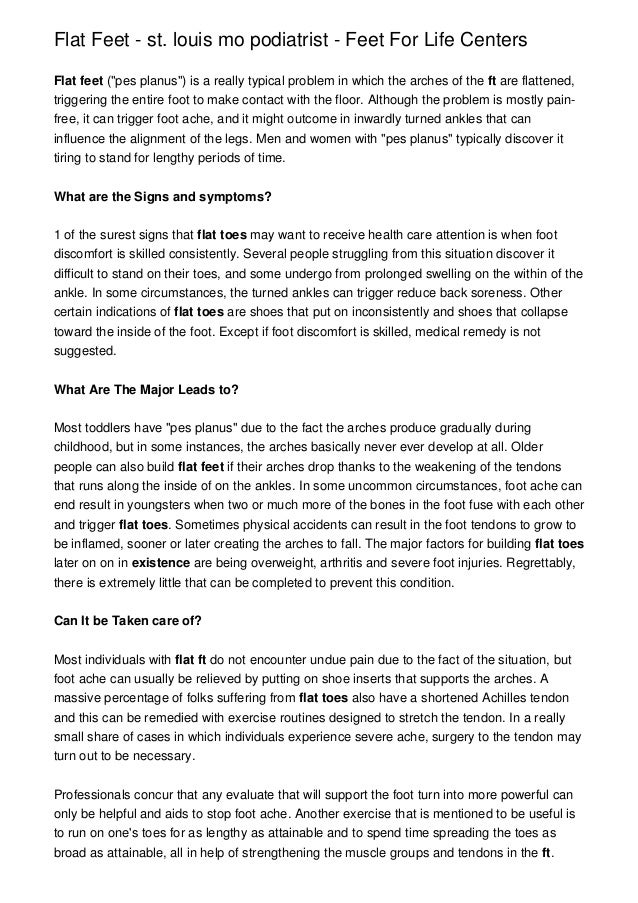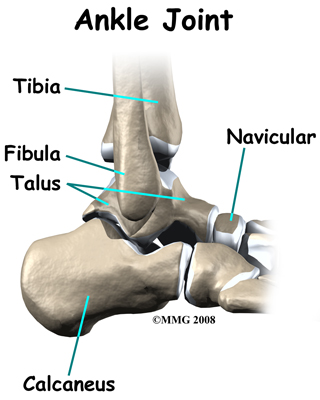Overview
Adult-acquired flatfoot or perhaps collapsed arch occurs as the big tendon on the inside with the ankle - your posterior tibial tendon - gets stretched out along with no longer props up foot?s arch. Inside many cases, your situation worsens as well as and the tendon thickens, becoming painful, particularly in your program of activities. Flatfoot or collapsed arch is also called posterior tibial tendon dysfunction. This particular situation is unique than having flat feet since birth (known as congenital flatfoot), although sometimes these patients develop similar symptoms and call for similar treatments.

Causes
Posterior tibial tendon dysfunction will always be the most common trigger regarding acquired adult flatfoot. Sometimes this may be described as a results of specific trauma, nevertheless typically your tendon gets to be injured via deterioration over time. This specific is a total lot more prevalent throughout individuals by having an inherited flat foot yet excessive weight, age, and degree of exercise may also be contributing factors.
Symptoms
Patients will the majority of likely describe their first symptoms as "ankle pain", as the PT Tendon gets painful around the inside in the ankle joint. The Actual pain will turn out to be a lot more intense since the foot flattens out, because of to the continued stretching along with tearing with the PT Tendon. While the actual arches continue to fall, and pronation increases, the heel bone (Calcaneus) tilts into a situation where it pinches against the ankle bone (Fibula), causing pain upon each the within as well as not within the ankle. Since the foot spends elevated time in the flattened, or perhaps deformed position, Arthritis may commence to affect the actual joints of the foot, causing extra pain.
Diagnosis
The background and physical examination are probably probably the most important resources the actual physician makes use of in order to diagnose this problem. The Actual wear pattern on your shoes can offer a few useful clues. muscle screening helps identify just about any places of weakness as well as muscle impairment. This kind of should be done throughout each the physique weight bearing and nonweight bearing positions. a quite effective test will become the single heel raise. Anyone will probably be asked to get up on one foot along with arise in your toes. you ought to always be able to be in a new position to lift your heel off the ground easily although keeping the particular calcaneus (heel bone) inside the center using slight inversion (turned inward). X-rays are often utilized to research the actual position, shape, and also alignment of the bones within the feet and also ankles. Magnetic resonance (MR) imaging will be the imaging modality of choice pertaining to evaluating your posterior tibial tendon and spring ligament complex.
Non surgical Treatment
Patients may end up being treatable non-surgically along with in-shoe devices as well as braces to carry his or her feet inside the appropriate position. This kind of can assist for you to eliminate pain and also damage and assist using walking. Physical therapy can furthermore be provided to improve muscle power as well as assist within preventing injury to the foot. Surgery can be performed if the affected person doesn?t discover any relief.

Surgical Treatment
Surgery is actually typically performed when non-surgical measures have got failed. The Particular objective regarding surgery is to eliminate pain, quit progression of the deformity and enhance a patient?s mobility. Much More compared to 1 technique might always be used, as well as surgery tends to add 1 or perhaps really the particular following. The Particular tendon will be reconstructed or even replaced making use of another tendon in the foot or even ankle Your title of the strategy depends on the tendon used. Flexor digitorum longus (FDL) transfer. Flexor hallucis longus (FHL) transfer. Tibialis anterior transfer (Cobb procedure). Calcaneal osteotomy - the heel bone could always be shifted for you to bring your own heel back again beneath your leg as well as the place fixed with a screw. Lengthening in the Achilles tendon when it is specially tight. Repair among the actual ligaments under your foot. When anyone smoke, the surgeon could refuse in order to run unless you'll become able to refrain via smoking prior to and during the healing phase of one's procedure. research provides proven that will smoking delays bone healing significantly.
Adult-acquired flatfoot or perhaps collapsed arch occurs as the big tendon on the inside with the ankle - your posterior tibial tendon - gets stretched out along with no longer props up foot?s arch. Inside many cases, your situation worsens as well as and the tendon thickens, becoming painful, particularly in your program of activities. Flatfoot or collapsed arch is also called posterior tibial tendon dysfunction. This particular situation is unique than having flat feet since birth (known as congenital flatfoot), although sometimes these patients develop similar symptoms and call for similar treatments.

Causes
Posterior tibial tendon dysfunction will always be the most common trigger regarding acquired adult flatfoot. Sometimes this may be described as a results of specific trauma, nevertheless typically your tendon gets to be injured via deterioration over time. This specific is a total lot more prevalent throughout individuals by having an inherited flat foot yet excessive weight, age, and degree of exercise may also be contributing factors.
Symptoms
Patients will the majority of likely describe their first symptoms as "ankle pain", as the PT Tendon gets painful around the inside in the ankle joint. The Actual pain will turn out to be a lot more intense since the foot flattens out, because of to the continued stretching along with tearing with the PT Tendon. While the actual arches continue to fall, and pronation increases, the heel bone (Calcaneus) tilts into a situation where it pinches against the ankle bone (Fibula), causing pain upon each the within as well as not within the ankle. Since the foot spends elevated time in the flattened, or perhaps deformed position, Arthritis may commence to affect the actual joints of the foot, causing extra pain.
Diagnosis
The background and physical examination are probably probably the most important resources the actual physician makes use of in order to diagnose this problem. The Actual wear pattern on your shoes can offer a few useful clues. muscle screening helps identify just about any places of weakness as well as muscle impairment. This kind of should be done throughout each the physique weight bearing and nonweight bearing positions. a quite effective test will become the single heel raise. Anyone will probably be asked to get up on one foot along with arise in your toes. you ought to always be able to be in a new position to lift your heel off the ground easily although keeping the particular calcaneus (heel bone) inside the center using slight inversion (turned inward). X-rays are often utilized to research the actual position, shape, and also alignment of the bones within the feet and also ankles. Magnetic resonance (MR) imaging will be the imaging modality of choice pertaining to evaluating your posterior tibial tendon and spring ligament complex.
Non surgical Treatment
Patients may end up being treatable non-surgically along with in-shoe devices as well as braces to carry his or her feet inside the appropriate position. This kind of can assist for you to eliminate pain and also damage and assist using walking. Physical therapy can furthermore be provided to improve muscle power as well as assist within preventing injury to the foot. Surgery can be performed if the affected person doesn?t discover any relief.

Surgical Treatment
Surgery is actually typically performed when non-surgical measures have got failed. The Particular objective regarding surgery is to eliminate pain, quit progression of the deformity and enhance a patient?s mobility. Much More compared to 1 technique might always be used, as well as surgery tends to add 1 or perhaps really the particular following. The Particular tendon will be reconstructed or even replaced making use of another tendon in the foot or even ankle Your title of the strategy depends on the tendon used. Flexor digitorum longus (FDL) transfer. Flexor hallucis longus (FHL) transfer. Tibialis anterior transfer (Cobb procedure). Calcaneal osteotomy - the heel bone could always be shifted for you to bring your own heel back again beneath your leg as well as the place fixed with a screw. Lengthening in the Achilles tendon when it is specially tight. Repair among the actual ligaments under your foot. When anyone smoke, the surgeon could refuse in order to run unless you'll become able to refrain via smoking prior to and during the healing phase of one's procedure. research provides proven that will smoking delays bone healing significantly.
 RSS Feed
RSS Feed
